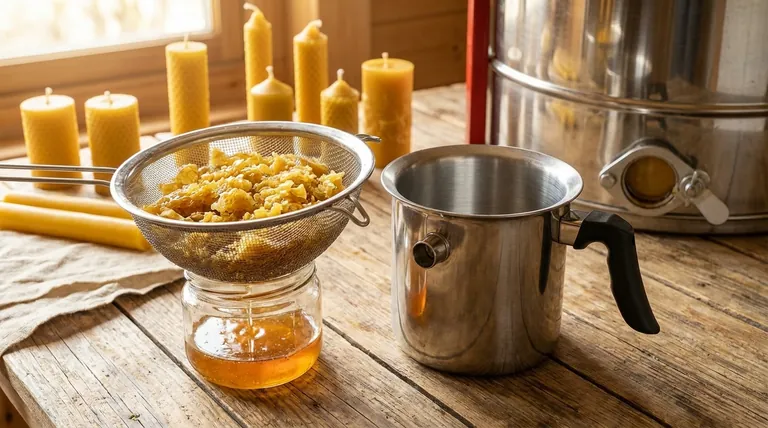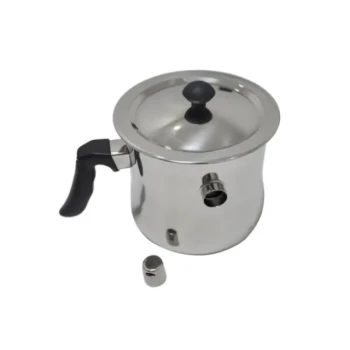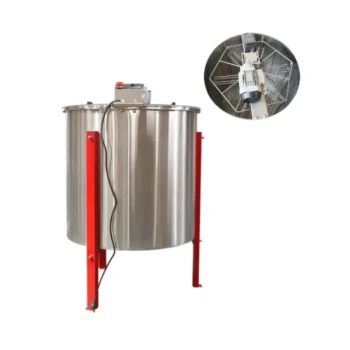After uncapping a honey frame, the removed wax cappings are collected in a container with a filter or screen. This setup allows the significant amount of residual honey clinging to the wax to drain and be collected, ensuring it becomes part of the main harvest.
The core principle is a two-stage recovery process: first, separate and save the valuable honey from the cappings, and second, clean and process the remaining beeswax for other uses.

The Two-Step Process for Handling Cappings
Effectively handling cappings is about maximizing your harvest and minimizing waste. The process naturally breaks down into two distinct, equally important stages.
Step 1: Recovering the Residual Honey
The mixture of wax and honey removed during uncapping is surprisingly honey-rich. The immediate goal is to separate these two components.
Cappings are typically placed into a colander, sieve, or a specialized uncapping tank that sits over a bucket or collection vessel.
Over several hours or even a day, gravity draws the liquid honey down through the filter, leaving the drier wax behind. This drained honey is then added to the rest of your harvest.
Step 2: Processing the Beeswax
Once the honey has been fully drained, the remaining beeswax is a valuable byproduct in its own right.
This wax can be washed, melted down, and filtered to remove impurities like residual honey or propolis. This clean, rendered beeswax is highly sought after.
Common Uses for Processed Beeswax
Cleaned beeswax is a stable, natural product with a wide range of applications, turning a simple byproduct into another valuable resource from your hives.
Candlemaking
One of the most traditional uses for beeswax is creating clean-burning, aromatic candles.
Cosmetics and Soaps
Due to its beneficial properties for skin, beeswax is a common ingredient in homemade or artisanal products like lip balms, salves, lotions, and soaps.
Understanding the Trade-offs
While the process is straightforward, the primary trade-off is between time and equipment. Your approach depends on the scale of your operation.
Simple Gravity Draining
For hobbyists with just a few hives, a simple bucket with a mesh filter is perfectly adequate. It costs very little but may require more time and manual effort to manage.
Dedicated Uncapping Tanks
For beekeepers with larger harvests, an uncapping tank is a worthwhile investment. These tanks are specifically designed to hold frames, catch cappings, and filter honey in a single, streamlined unit, making the workflow much more efficient.
Not Processing the Wax
Simply discarding the wax after draining the honey is a common mistake for beginners. You are throwing away a valuable and useful material that can be used or sold.
Making the Right Choice for Your Goal
Your approach to handling cappings should align with the scale of your beekeeping and your ultimate goals.
- If your primary focus is a small, simple harvest: A bucket and a large sieve are all you need to effectively separate your honey and wax.
- If your primary focus is efficiency with larger harvests: Investing in a dedicated uncapping tank will save significant time and streamline your entire extraction process.
- If your primary focus is maximizing the value of your hive: Commit to both draining the honey and then rendering the wax for use in other products like candles or cosmetics.
Properly handling your cappings transforms a messy byproduct into an additional stream of value from your beehives.
Summary Table:
| Step | Process | Key Equipment | Outcome |
|---|---|---|---|
| 1 | Recover Honey | Colander, Sieve, or Uncapping Tank | Drains residual honey into the main harvest |
| 2 | Process Beeswax | Melter & Filter | Creates clean wax for candles, soaps, and balms |
Maximize the value of every harvest with HONESTBEE.
As a leading wholesale supplier to commercial apiaries and equipment distributors, we understand that efficiency and yield are your top priorities. Our specialized uncapping tanks and wax processing equipment are designed to streamline your workflow, ensuring you recover every drop of honey and every ounce of valuable beeswax.
Let us help you turn a messy byproduct into a profitable resource. Contact HONESTBEE today to discuss wholesale solutions for your operation.
Visual Guide

Related Products
- Beeswax Melter for Candle Making Honey Bee Wax Melter
- Fully Automatic Beeswax Embossing Machine Foundation Mill
- Beeswax Machine Press Embosser Wax Foundation Mold Printer Bee Hive Equipment Making Sheet
- Stainless Steel Manual Honey Press with Guard for Pressing Honey and Wax
- Colorful Silicone Beeswax Foundation Mold Mould for Beekeeping
People Also Ask
- What are the primary products of honey bee farming besides honey? Discover the Hive's Hidden Treasures
- What is the best way to melt beeswax for candles? The Safest Method for Professional Results
- How do water jacket melters function? Achieve Gentle, Scorch-Free Melting for Sensitive Materials
- What is the recommended temperature range for melting beeswax? Achieve Perfect Quality & Safety
- What do you use a wax melter for? From Home Fragrance to Professional Beekeeping



















